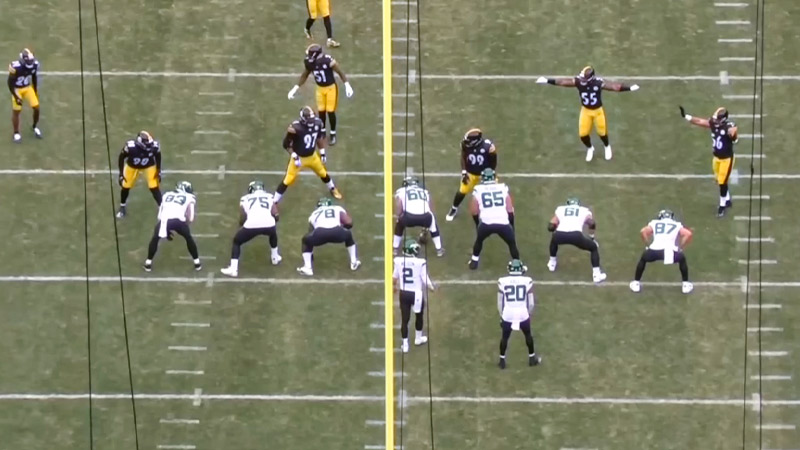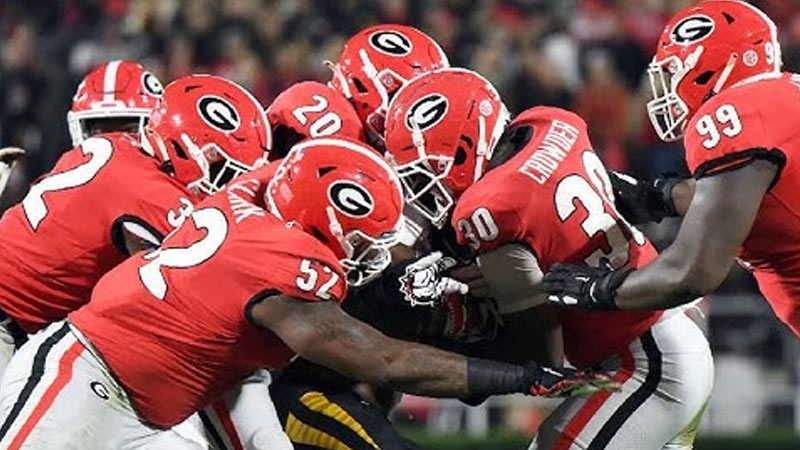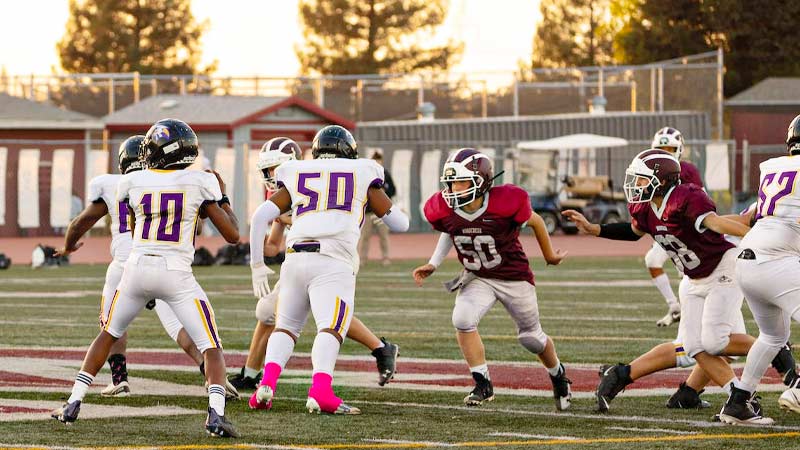In the world of American football, defensive strategies play a pivotal role in determining the outcome of games. One such intriguing defensive formation that has captured the attention of coaches, players, and enthusiasts alike is the Football 3-3 Defense.
With its dynamic approach and emphasis on adaptability, this defensive scheme has the potential to disrupt opposing offenses and create game-changing moments on the field.
In this comprehensive guide, we delve into the intricacies of the Football 3-3 Defense, addressing frequently asked questions, exploring its advantages, and shedding light on the challenges it presents.
What is Football 3-3 Defense?
The 3-3 defense is a strategic formation utilized in American football, emphasizing versatility and adaptability. It involves three defensive linemen and three linebackers at the front, supported by five defensive backs.
This scheme aims to disrupt opponents’ passing and running plays by maintaining a balanced approach to stopping both elements of the offense. The three down linemen exert pressure on the quarterback while the linebackers provide coverage and assist in run defense.
The 3-3 defense is known for its ability to confuse offenses with varied blitzes and coverage schemes. It offers flexibility to adjust to different offensive strategies, making it a dynamic choice for teams aiming to control the game’s pace and limit opponents’ scoring opportunities.
Responsibilities of Football 3-3 Defense

The Football 3-3 Defense assigns specific responsibilities to its players to effectively counter the opposing offense. Here’s a breakdown of the key responsibilities for each position:
Defensive Linemen (3)
Nose Tackle (NT): Lines up over the center, responsible for disrupting the offensive line, clogging running lanes, and occupying blockers to free up linebackers.
Defensive Ends (DE): Align on the edges of the offensive line. Their primary tasks include containing outside runs, setting the edge, and putting pressure on the quarterback during passing plays.
Linebackers (3)
Inside Linebackers (ILB): Positioned behind the defensive linemen, they have dual roles – stopping the run by filling gaps and pursuing ball carriers, as well as providing coverage against short to intermediate passes.
Outside Linebackers (OLB): Located on the edges, they have similar responsibilities to DEs but often drop into coverage. They need to cover tight ends, support against outside runs, and occasionally blitz the quarterback.
Defensive Backs (5)
Cornerbacks (CB): Defend against wide receivers, aiming to disrupt routes, prevent receptions, and occasionally support against the run. They must have good coverage skills and speed.
Safeties (S): Two safeties play deep zones and provide the last line of defense. They help prevent deep passes, read the quarterback’s intentions, and provide support against both the run and the pass.
The 3-3 Defense focuses on flexibility, disguising coverages, and applying pressure from different angles through well-timed blitzes. Players must communicate effectively to adjust to the offense’s movements and execute their roles to control the line of scrimmage, limit yardage gained, and force turnovers.
Key Principles of the 3-3 Defense

The 3-3 Defense in American football is built upon a set of key principles that guide its execution. These principles emphasize adaptability, versatility, and strategic play. Here are the key principles of the 3-3 Defense:
Versatility and Flexibility
The 3-3 Defense is designed to adapt to various offensive formations and strategies. Its structure allows for quick adjustments, making it effective against both run-heavy and pass-heavy offenses. This adaptability keeps opponents guessing and prevents them from exploiting defensive weaknesses.
Disguised Blitzing
A hallmark of the 3-3 Defense is its ability to disguise blitzes and coverages. By sending different combinations of linebackers and defensive backs on blitzes, the defense can confuse quarterbacks and disrupt their timing. This keeps the offense off balance and disrupts their game plan.
Gap Integrity
Defenders in the 3-3 Defense are responsible for maintaining gap integrity. This means each player is assigned specific run gaps to fill, ensuring that running backs are met with resistance at the line of scrimmage. Gap discipline prevents big running plays and forces ball carriers into congested areas.
Balanced Run and Pass Defense
The defense aims to balance its focus on stopping both the run and the pass. While maintaining stout run defense, linebackers, and defensive backs must also effectively cover receivers and tight ends. This balanced approach prevents opponents from exploiting predictable defensive tendencies.
Coverage Rotation
The 3-3 Defense employs rotation and shifting of coverage responsibilities among defensive backs. This rotation confuses quarterbacks, making it challenging for them to identify open targets. It also enables the defense to provide help over the top and quickly react to offensive movements.
Pressure and Containment
Defensive linemen and outside linebackers play crucial roles in pressuring the quarterback and containing outside runs. By applying pressure from the edges and keeping containment, the defense limits the quarterback’s time to make decisions and prevents big plays around the perimeter.
Communication and Recognition
Effective communication among defenders is vital in the 3-3 Defense. Players must recognize offensive formations, shifts, and pre-snap cues to adjust their alignments and responsibilities accordingly. Strong communication ensures seamless transitions between coverages and blitz packages.
Forcing Turnovers
The defense actively seeks to create turnovers by stripping the ball, intercepting passes, and recovering fumbles. With its dynamic and unpredictable nature, the 3-3 Defense can catch offenses off guard and create opportunities to swing the momentum in favor of the defense.
The 3-3 Defense is rooted in adaptability, deception, and disciplined execution. Its principles enable defenders to control the flow of the game, disrupt opponents’ strategies, and create game-changing plays.
Drills and Practice Strategies of 3-3 Defense

To effectively implement and refine the 3-3 Defense in American football, coaches can employ specific drills and practice strategies that align with its principles. Here are some drills and practice strategies tailored to the 3-3 Defense:
Gap Responsibility Drill
Emphasize gap integrity and run defense by setting up scenarios where defenders practice filling their assigned gaps against run plays. Coaches can simulate various offensive formations and run plays to ensure defenders understand their responsibilities and execute proper gap control.
Blitz Recognition and Communication
Focus on recognizing blitz situations and communicating adjustments among defenders. Run drills where defenders must quickly identify and communicate the blitz, adjust their coverage responsibilities, and execute the play as a cohesive unit.
Coverage Rotation Simulation
Set up scenarios that mimic different offensive formations and shifts. Have defensive backs practice rotation and shifting of coverage responsibilities based on offensive movement. This drill enhances communication, ensures proper coverage, and helps defenders react to changing situations.
Disguised Blitz Practice
Teach defenders how to disguise blitzes effectively. Use drills where defenders practice showing one alignment or coverage before the snap but quickly shift into a blitz or different coverage post-snap. This skill can confuse quarterbacks and disrupt their timing.
One-on-One Pass Rush Drills
Develop pass rush techniques among defensive linemen and outside linebackers. Use one-on-one pass rush drills where players work on hand placement, leverage, and shedding blocks to pressure the quarterback effectively.
Zone Coverage Drills
Focus on improving zone coverage skills among linebackers and defensive backs. Implement drills that emphasize reading the quarterback’s eyes, maintaining proper depth, and effectively passing off receivers within zone assignments.
Tackling Circuit
Prioritize tackling fundamentals with a tackling circuit that includes various tackling techniques and scenarios. Emphasize proper form, leverage, and tackling angles to ensure sound tackling skills in run-and-pass defense.
Game Simulation
Conduct controlled scrimmages or situational drills that simulate game scenarios. Replicate different offensive plays and situations to test the defense’s ability to adjust, communicate, and execute the 3-3 Defense principles under game-like conditions.
Film Study
Incorporate film study sessions to review practice drills and analyze opponents’ tendencies. Break down the film to identify areas for improvement, reinforce key principles, and enhance players’ understanding of how the 3-3 Defense can be effectively applied in specific game situations.
Communication Exercises
Dedicate time to communication exercises where players practice relaying pre-snap adjustments, coverage calls, and blitz signals. Clear and efficient communication is crucial for executing the 3-3 Defense cohesively.
Consistent practice of these drills and strategies can help players develop the skills, understanding, and teamwork required to execute the 3-3 Defense successfully on the field.
Advantages of 3-3 Defense

The 3-3 Defense in American football offers several distinct advantages that can make it a formidable choice for teams looking to disrupt opposing offenses and control the game. Some key advantages of the 3-3 Defense include:
Versatility
The 3-3 Defense is highly adaptable to various offensive formations and strategies. Its flexibility allows coaches to adjust quickly and effectively to different game situations, making it challenging for opponents to exploit defensive weaknesses.
Confusion and Deception
The defense’s ability to disguise blitzes and coverages can confuse quarterbacks and disrupt their timing. This deception forces offenses to hesitate, providing defensive players valuable split-seconds to make plays.
Balanced Run and Pass Defense
The 3-3 Defense is designed to counter both the run and the pass effectively. Its structure allows for stout run defense with disciplined gap control, while also providing coverage support to defend against passing plays.
Pressure on Quarterback
By utilizing disguised blitzes and creative pass-rushing schemes, the 3-3 Defense can generate consistent pressure on the quarterback from multiple angles. This pressure disrupts passing lanes, leads to hurried throws, and increases the likelihood of sacks and turnovers.
Coverage and Ball Disruption
The defense’s emphasis on coverage rotation and zone principles can lead to interceptions, deflections, and forced fumbles. The dynamic nature of the 3-3 Defense keeps quarterbacks uncertain about where defenders will be, increasing the chances of creating turnovers.
Containment of Outside Runs
The 3-3 Defense’s structure and edge defenders help contain outside runs effectively. This containment prevents running backs from breaking to the outside and forces them to run into traffic, limiting their yardage gains.
Personnel Flexibility
The 3-3 Defense allows coaches to utilize a mix of defensive linemen, linebackers, and defensive backs based on the strengths of their roster. This flexibility enables teams to adjust their personnel to match up against specific opponents and offensive styles.
Communication and Teamwork
The defense’s success relies heavily on communication and teamwork. Players must effectively communicate adjustments and responsibilities, fostering a cohesive and disciplined unit that can react swiftly to offensive movements.
Control of Game Pace
The 3-3 Defense’s ability to disrupt opponents and force turnovers can shift the momentum of games in favor of the defensive team. By controlling the tempo and limiting scoring opportunities, the defense can influence the overall flow of the game.
Adapting to Modern Offenses
With the rise of dynamic passing offenses and versatile quarterbacks, the 3-3 Defense provides a strategic response to modern offensive trends. Its ability to counter both the run and the pass aligns well with the evolving nature of the game.
The 3-3 Defense’s adaptability, deception, pressure, and balanced approach make it a compelling choice for teams aiming to control the field and challenge opposing offenses. When executed effectively, it can disrupt game plans, create turnovers, and provide a competitive edge.
Disadvantages of 3-3 Defense
While the 3-3 Defense in American football offers several advantages, it also comes with its share of potential disadvantages and challenges that coaches and teams need to consider. Some of the disadvantages of the 3-3 Defense include:
Vulnerability to Power Running Game
The 3-3 Defense’s emphasis on flexibility and coverage can sometimes leave it susceptible to a strong power running game. Against teams with powerful offensive linemen and running backs, the defense might struggle to consistently stop inside runs and short-yardage situations.
Mismatch Against Bigger Offensive Lines
The 3-3 Defense’s reliance on three down linemen could lead to mismatches against larger offensive lines. If the offensive line is able to overpower the defensive line, it could create running lanes and protection for the quarterback, limiting the effectiveness of the pass rush.
Limited Pass Rush
While the 3-3 Defense can generate pressure through blitzes and creative pass-rushing schemes, it might have limitations in generating consistent pass rush solely from the front three linemen. This could potentially expose the defense to longer passing plays and give quarterbacks more time to find open receivers.
Coverage Gaps
The dynamic nature of the 3-3 Defense, with rotations and disguised coverages, can occasionally lead to breakdowns in coverage assignments. Miscommunication or errors in coverage rotation could result in wide-open passing lanes and big gains for the opposing offense.
Complexity and Learning Curve
Implementing the 3-3 Defense effectively requires a strong understanding of its principles and constant communication among defenders. The complexity of the scheme might lead to a steeper learning curve, especially for younger or less experienced players.
Personnel Limitations
The success of the 3-3 Defense often depends on having versatile and skilled linebackers who can excel in both run defense and coverage. If a team lacks the necessary personnel for this scheme, it might not be as effective in executing its principles.
Exploitation by Quick-Passing Offenses
Quick-passing offenses can neutralize the 3-3 Defense’s ability to generate pressure and disrupt timing. Short, fast-paced passing plays can minimize the impact of blitzes and prevent the defense from getting to the quarterback.
Run Defense at the Edges
While the 3-3 Defense aims to contain outside runs, it could be susceptible to misdirection plays and reverses that exploit the edges and create open space.
Risk of Big Plays
The aggressive nature of the 3-3 Defense, particularly with blitzes, can leave the defense vulnerable to big plays if the blitz is not executed successfully. If a blitz is picked up by the offensive line or a quick pass is released, it could lead to potential big gains for the offense.
Adjustment to Opponent
While the 3-3 Defense is versatile, it might require significant adjustments to counter specific opponent strengths and strategies. If the defense is not able to effectively adjust during the game, it could struggle against well-prepared offenses.
While the 3-3 Defense offers numerous benefits, coaches, and teams must carefully assess their personnel and opponents to determine if it is the right defensive scheme for their situation. Awareness of its potential disadvantages and strategic planning can help mitigate these challenges and maximize the defense’s effectiveness.
FAQs
What is the Football 3-3 Defense?
The Football 3-3 Defense is a strategic formation employed by defensive units to counter a wide range of offensive plays. It features three defensive linemen and three linebackers at the front, supported by five defensive backs.
This scheme aims to provide a balanced approach, effectively defending against both running and passing plays while maintaining the flexibility to adjust to various offensive strategies.
What are the key principles of the 3-3 Defense?
The key principles of the 3-3 Defense revolve around versatility, gap integrity, balanced run and pass defense, disguised blitzing, coverage rotation, pressure on the quarterback, communication, and the ability to force turnovers.
These principles work in tandem to create a formidable defensive unit that can adapt to different scenarios and disrupt opponents’ strategies.
What are the advantages of using the 3-3 Defense?
The 3-3 Defense offers several advantages, including its versatility against different offensive formations, its ability to confuse and deceive quarterbacks, balanced run and pass defense, consistent pressure on the quarterback, effective coverage and ball disruption, and the capability to adapt to modern offensive trends.
These advantages make it a compelling choice for teams aiming to control the game’s tempo and limit opponents’ scoring opportunities.
What are the potential disadvantages and challenges of the 3-3 Defense?
While the 3-3 Defense has its strengths, it also has potential disadvantages. These include vulnerability to power running games, potential mismatches against larger offensive lines, limited pass rush from the front three linemen, complexities in coverage rotation, a learning curve for players, and the risk of exploitation by quick-passing offenses.
How can teams practice and refine the 3-3 Defense?
To effectively implement and refine the 3-3 Defense, teams can engage in drills and practice strategies such as gap responsibility drills, blitz recognition and communication exercises, coverage rotation simulations, disguised blitz practices, one-on-one pass rush drills, zone coverage drills, tackling circuits, game simulations, and film study sessions.
Wrapping Up
In the ever-evolving landscape of American football, the Football 3-3 Defense stands as a dynamic and strategic choice for teams seeking to disrupt opponents and gain an edge on the field.
Its adaptability, versatility, and emphasis on communication make it a potent defensive scheme that can influence game outcomes.
By understanding its principles, advantages, and challenges, and practicing its strategies diligently, teams can harness the potential of the 3-3 Defense to make impactful plays, control the game’s tempo, and emerge victorious against formidable adversaries.
Thank you for your time.







